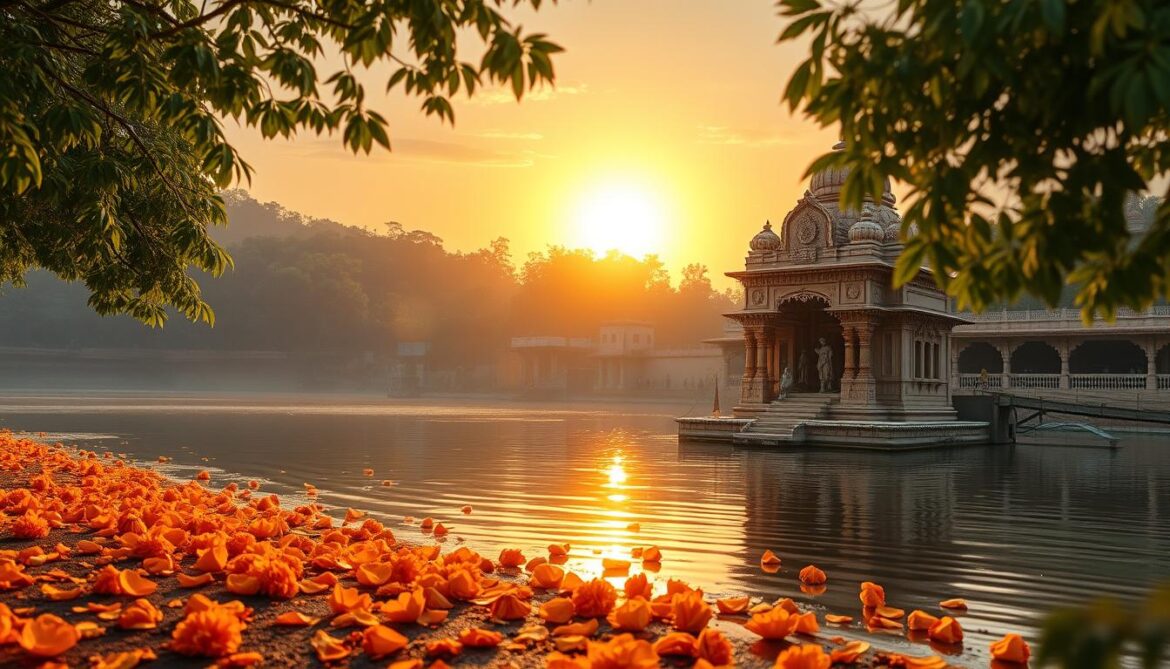Meerabai lived in the 16th century. She was a mystic poetess who loved Lord Krishna. She wrote poems and bhajans, like Payo Ji Maine Ram Ratan Dhan Payo. This song became famous, thanks to Salman Khan.
Meerabai was a big fan of Lord Krishna. Her life and work inspire many. Her art, like paintings and sculptures of Lord Krishna, is very special in India.
Meerabai wrote in Rajasthani and Braj Bhasha. Her poems and bhajans, like Payo Ji Maine Ram Ratan Dhan Payo, are loved in Bollywood. Salman Khan has also sung this song, showing Meerabai’s lasting love for Lord Krishna.
Introduction to Payo Ji Maine Ram Ratan Dhan Payo
The bhajan Payo Ji Maine Ram Ratan Dhan Payo is a beloved song by Meerabai, a poet from the 16th century. Sooraj Barjatya, a famous film director, included it in his 2015 movie Prem Ratan Dhan Payo. This song was a big hit, earning over ₹432 crore at the box office.
It’s also a favorite during Diwali, bringing joy and devotion to all who listen.
Meerabai’s life and devotion are closely linked to this bhajan. Her poetry and songs show her deep love for Lord Krishna. The song Payo Ji Maine Ram Ratan Dhan Payo shows her faith and love for the divine. Its dance performances have become a big part of Indian culture.
Overview of the Bhajan’s Significance
This bhajan is more than just a song. It’s a powerful expression of devotion, love, and surrender. It touches the hearts of people everywhere. The song’s themes of spiritual longing and selfless devotion have inspired many performances over the years.
Historical Context of Meerabai
Meerabai lived in the 16th century and was from the royal family of Mewar. She was known for her deep devotion to Lord Krishna. Her poetry and songs show her spiritual longing and pursuit of divine love.
Sooraj Barjatya’s films, like Prem Ratan Dhan Payo, have made Meerabai’s work more popular. They feature iconic dance performances that highlight the song’s beauty and importance.
The Life of Meerabai: A Blessed Seer
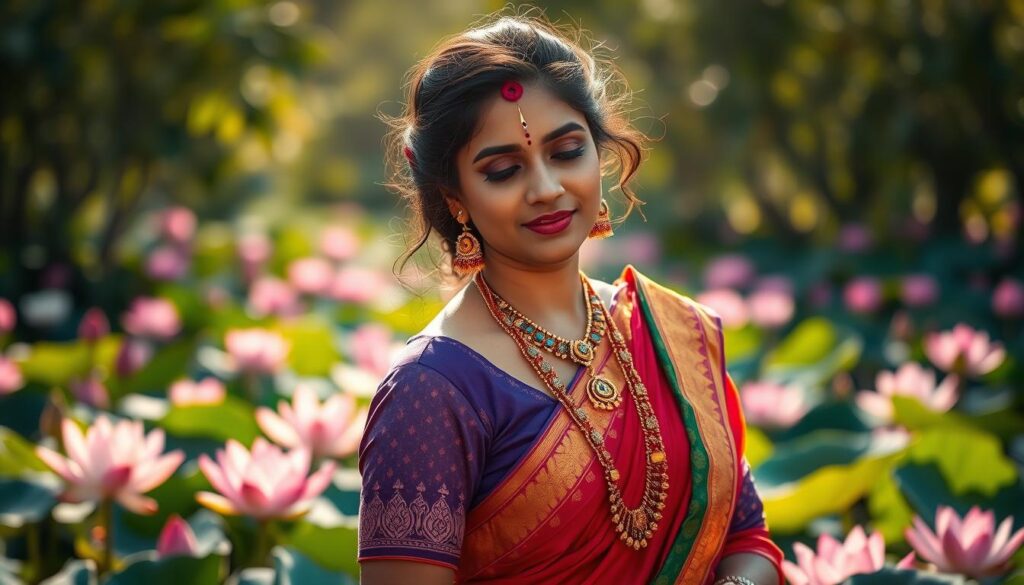
Meerabai was born around 1498 in present-day Rajasthan, India. She died around 1546 at the age of 47-48 in present-day Gujarat, India. Her life was filled with spiritual awakening and devotion to Lord Krishna.
Her traditional attire and colorful celebrations show her deep faith. They also highlight her connection to her cultural heritage.
Meerabai’s spiritual journey started young. She wrote many devotional hymns praising Krishna. Her most famous work, “Payoji maine Ram Ratan dhan payo,” is well-known.
Her life was not easy, but her faith in Lord Krishna helped her. It guided her through tough times.
- She got married in 1516 and her husband died in 1521.
- Meerabai composed numerous devotional hymns, with only a few hundred considered authentic.
- Her poems are known for their beautiful language and style, which have been analyzed by scholars to establish their authenticity.
Meerabai’s legacy inspires people today. Her story shows the power of faith and devotion. Her traditional attire and colorful celebrations are key parts of her story. They show her love for Lord Krishna and her cultural heritage.
Understanding the Bhajan’s Lyrics
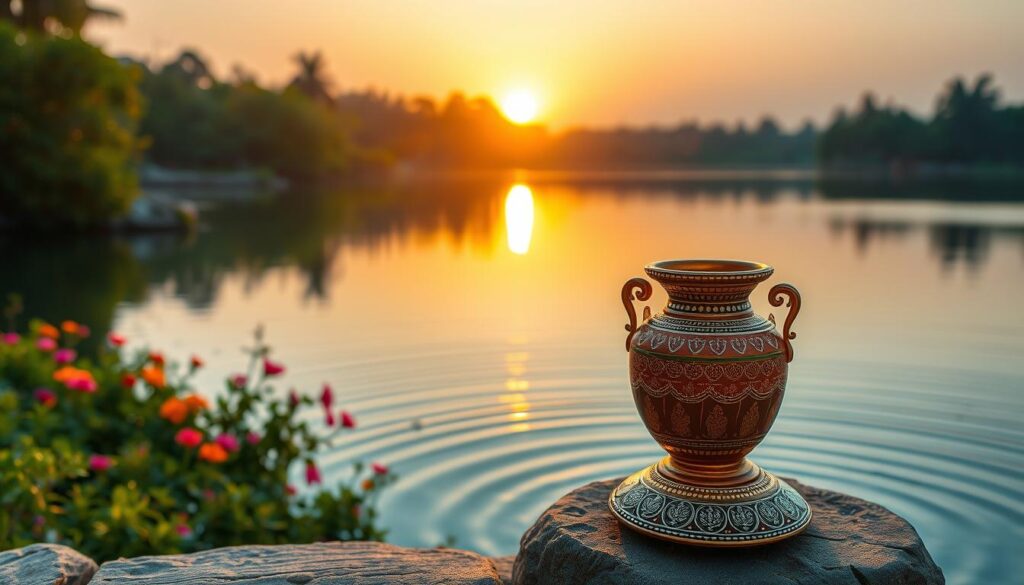
The bhajan Payo Ji Maine Ram Ratan Dhan Payo shows deep love and devotion. Its lyrics have been seen in many ways. It uses metaphors and allegories to talk about the divine.
For example, it compares God to a precious jewel given by the Guru. This is a common theme in Kabir’s poetry.
The lyrics show Meerabai’s love for Rama and Krishna. They show her belief in the power of divine names and forms. Words like “raam” and “naam” highlight the complexity of the lyrics.
The bhajan has been featured in several Bollywood song adaptations. A famous version was by Pandit D V Paluskar.
Some key features of the bhajan’s lyrics include:
- The use of metaphors and allegories to describe the divine
- The comparison of God to a precious jewel given by the Guru
- The devotion to Rama and Krishna, showing the belief in divine names and forms
Artists like Lata Mangeshkar and Pt. D. V. Paluskar have performed the bhajan. They have made the language more accessible to more people. The evolution of the bhajan through different singers has made it unique and dynamic.
Discussions about the bhajan include many interpretations and analyses. It is important in Indian classical music and devotional literature. It combines cultural, literary, and historical contexts.
| Artist | Song Title | Year |
|---|---|---|
| Pandit D V Paluskar | Payo Ji Maine Ram Ratan Dhan Payo | 1944 |
| Lata Mangeshkar | Payo Ji Maine Ram Ratan Dhan Payo | 1952 |
Musical Interpretations of the Bhajan
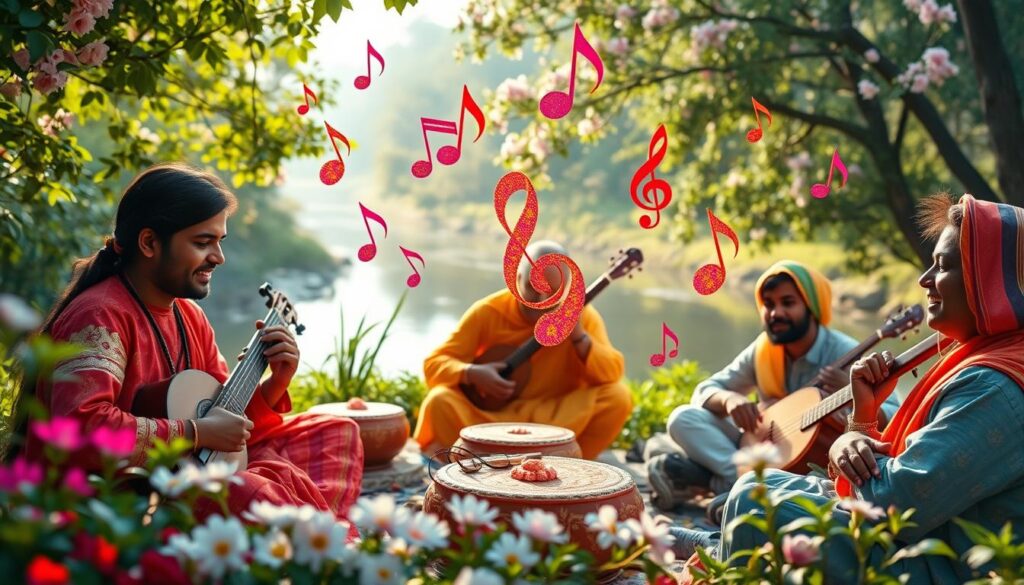
The bhajan “Payo Ji Maine Ram Ratan Dhan Payo” has been seen in many ways by famous artists. Anup Jalota’s version shows its deep cultural and emotional value. Iconic dance by Salman Khan has also made it very popular in India.
Many musicians have shaped the bhajan through their art. Some key points include:
- Instrumentation changes, from traditional to modern
- Vocal styles, from classical to modern and folk
- Collaborations that create new sounds
The bhajan’s message of devotion and spirituality touches hearts around the world. Salman Khan’s iconic dance shows how it’s a big part of Indian culture. It goes beyond old traditions and reaches more people.
| Artist | Instrumentation | Vocal Style |
|---|---|---|
| Anup Jalota | Traditional Indian instruments | Classical |
| Salman Khan | Orchestral arrangements | Contemporary |
| Other artists | Variations of traditional and modern instruments | Fusion of classical and contemporary styles |
The Cultural Impact of the Bhajan
The bhajan “Payo Ji Maine Ram Ratan Dhan Payo” has a big impact on culture, big during festivals and celebrations. It’s a favorite Diwali song that unites people, showing community and devotion. The traditional clothes worn add to its cultural value, making the atmosphere lively and festive.
The bhajan’s effect on today’s devotional music is impressive. Many artists have made their own versions, mixing different music styles and instruments. This makes the bhajan stay current, reaching new music fans. Famous artists like Lata Mangeshkar and Pt. D.V. Paluskar have made it popular with their special versions.
The bhajan’s cultural impact is clear in how it crosses boundaries and unites people. It shows the power of music and devotion, highlighting the importance of traditional clothes and culture today. As a Diwali song, it remains a key part of celebrations, spreading joy and happiness.
| Artist | Version | Year |
|---|---|---|
| Lata Mangeshkar | Classical | 1960 |
| Pt. D.V. Paluskar | Traditional | 1950 |
| Modern Artists | Fusion | 2020 |
The bhajan’s lasting impact on devotional music shows its cultural importance. As a Diwali song, it’s a big part of celebrations, bringing joy and togetherness. The traditional clothes and practices linked to the bhajan make its cultural value even greater, creating a lively and festive atmosphere that brings people together.
Faith and Philosophy in Meerabai’s Teachings

Meerabai’s teachings are based on spiritual surrender. This is seen in her bhajans, like Payo Ji Maine Ram Ratan Dhan Payo. This song is a key part of her devotion to Krishna, showing her spiritual beliefs.
Her teachings focus on love without limits. This is a big part of her philosophy. Her songs, including Payo Ji Maine Ram Ratan Dhan Payo, are in many Bollywood films. They show her teachings are loved today just as much as they were back then.
- The importance of spiritual surrender and devotion to a higher power
- The universal appeal of love and compassion, transcending boundaries and borders
- The significance of music and art in expressing spiritual emotions and experiences
Meerabai’s teachings keep inspiring people everywhere. Her bhajans, like Payo Ji Maine Ram Ratan Dhan Payo, show the lasting impact of faith and philosophy. They shape our lives and experiences.
The Bhajan in Popular Media
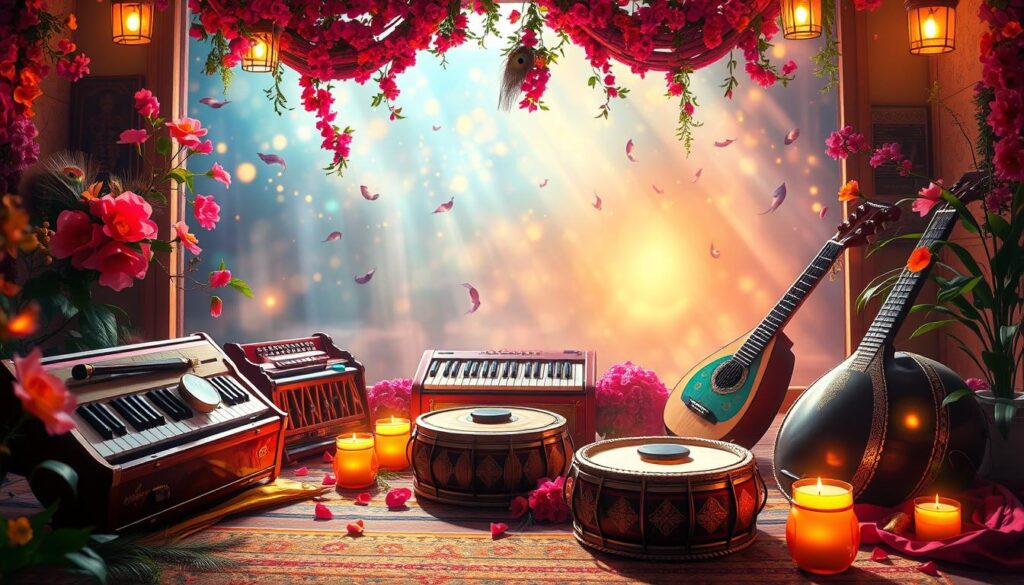
The bhajan “Payo Ji Maine Ram Ratan Dhan Payo” has been in many films and TV shows. Salman Khan and Sooraj Barjatya helped make it famous. They did this through their work in movies.
Here are some examples of the bhajan in popular media:
- Films: The bhajan has been in several Bollywood movies. It shows its lasting appeal and importance today.
- TV Shows: It has been sung on TV, like in music reality shows and devotional programs.
The bhajan’s place in popular media shows its timeless charm. It also shows how Salman Khan and Sooraj Barjatya helped it grow. It keeps inspiring and influencing music fans and devotees.
| Performance | Influence |
|---|---|
| Salman Khan’s film | Introduced the bhajan to more people |
| Sooraj Barjatya’s film | Highlighted the bhajan’s emotional power |
How to Incorporate the Bhajan in Daily Life
Adding the bhajan to your daily routine can boost devotion and spiritual growth. Singing or listening to bhajans is a great way to do this. Wearing traditional attire can make the experience even more special.
Joining in colorful celebrations and festivals is another fun way to connect with others. Here are some tips to make the bhajan a part of your day:
- Start by listening to or singing bhajans every day, like during meditation or prayer
- Join in colorful celebrations and festivals for fun and to show devotion
- Wear traditional attire when practicing devotion to feel closer to the divine
By making the bhajan a daily part of your life, you can feel more connected to the divine. You can do this through music, celebrations, or traditional attire. There are many ways to make the bhajan meaningful in your daily routine.
Practicing bhakti yoga, which includes singing bhajans, offers many benefits. It can reduce stress, improve flexibility, and bring inner peace. By incorporating the bhajan into your daily life, you can enjoy these benefits and grow spiritually.
| Benefits of Bhakti Yoga | Description |
|---|---|
| Stress Reduction | Bhakti yoga can help reduce stress and anxiety by promoting relaxation and calmness |
| Improved Flexibility | Regular practice of bhakti yoga can improve flexibility and balance |
| Inner Peace | Bhakti yoga can help cultivate a sense of inner peace and connection to the divine |
Conclusion: The Lasting Legacy of Payo Ji Maine Ram Ratan Dhan Payo
Meerabai’s song, “Payo Ji Maine Ram Ratan Dhan Payo,” has left a lasting mark. It shows her strong faith and love for the divine. This song, from the Salman Khan film, has become a spiritual awakening anthem.
Meerabai’s life teaches us about devotion and finding joy in simple acts. Her songs are full of deep emotions and wisdom. They inspire many to seek self-discovery and divine love.
Let’s bring Meerabai’s wisdom into our lives. She taught us to let go and find peace in the divine. Her legacy encourages us to connect with the sacred and find solace in devotional music.

